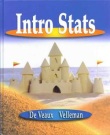
Math 141 - Introductory Statistics- Spring 2008
Reading Assignments
All assignments are from Intro Stats by De Veaux and Velleman, 2004 edition.
For January 28
Chapter 1 Stats Starts Here
Chapter 2 Data
Chapter 12 Sample Surveys
Chapter 13 Experiments
Chapter 3 Displaying Categorical Data
Chapter 4 Displaying Quantitative Data
To read : Skim Chapters 1 and 2 to remind
yourself of the first day of class
Read all of Chapters 12, 13, 3, and 4, although you can skip the optional section in Chapter 4 that begins on page 44
Reading Questions :
- Explain the difference between a population parameter and a sample statistic.
- Explain the advantages of an experiment over a retrospective study.
- Describe the shape of the distribution given in Exercise 7 of Chapter 4 on page 50.
For February 4
Chapter 5 Describing Distributions Numerically
Chapter 6 The Standard Deviation as a Ruler and the Normal Model
To read : All
Reading Questions :
- Give the median and interquartile range of the following data set.
7, 9, 12, 19, 4, 1, 10, 12, 13
- Give an example where the median is a better measure of the center of a distribution than the mean. Explain.
- Why would you want to standardize a data set?
For February 11
Chapter 18 Sampling Distribution Models
Chapter 19 Confidence Intervals for Proportions
To read : All
Reading Questions :
- What does each data point in a sampling distribution represent?
- In a couple of sentences, explain the idea of the Central Limit Theorem in your own words.
- In two or three sentences, explain the idea of a confidence interval for a parameter in your own words.
For February 18
Chapter 19 Confidence Intervals for Proportions
Chapter 20 Testing Hypotheses about Proportions
To read : Reread Chapter 19, and read all of Chapter 20
Reading Questions :
- What is a null hypothesis?
- What does the p-value tell you about the null hypothesis?
For February 25
No Reading Assignment because of Exam 1 on Wednesday.
For March 3
Chapter 20 Testing Hypotheses about Proportions
Chapter 21 More about Tests
Chapter 23 Inferences about Means
To read : Reread Chapter 20
Read Chapter 21 (you can skip the sections on pp 399-400) and Chapter 23
Reading Questions :
- Explain the difference between a Type I and Type II error.
- Why do we need to use the Student's t-test rather than the techniques from Chapter 20?
For March 17
Chapter 22 Comparing Two Proportions
Chapter 24 Comparing Means
To read : All
Reading Questions :
- What is the purpose of Chapter 22?
- What is the difference between a two-sample t-test and a pooled t-test?
For March 24
Chapter 25 Paired Samples and Blocks
Chapter 26 Comparing Counts
To read : All
Reading Questions :
- Explain the difference between a paired t-test and a two sample t-test. Give examples to explain when you would use one over the other.
- What does the chi-square statistic measure? Explain the idea in your own words in a couple of sentences.
For March 31
Chapter 28 Analysis of Variance
To read : All, but you can skip the section on Bonferroni multiple comparisons
No Reading Questions for this week.
For April 7
No Reading Assignment because of Exam 2 on Wednesday.
For April 14
Chapter 7 Scatterplots, Association, and Correlation
Chapter 8 Linear Regression
Chapter 9 Regression Wisdom
To read : All
Reading Questions :
- What is the purpose of regression?
- What does the correlation coefficient r measure?
- What is a residual?
For April 21
Chapter 29 Multiple Regression
To read : All
Reading Questions :
- How does multiple regression differ from the linear regression models we discussed in Chapter 8?
- What is the advantage of multiple regression over the models from Chapter 8?

Last Modified May 7, 2009 10:14 PM